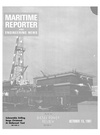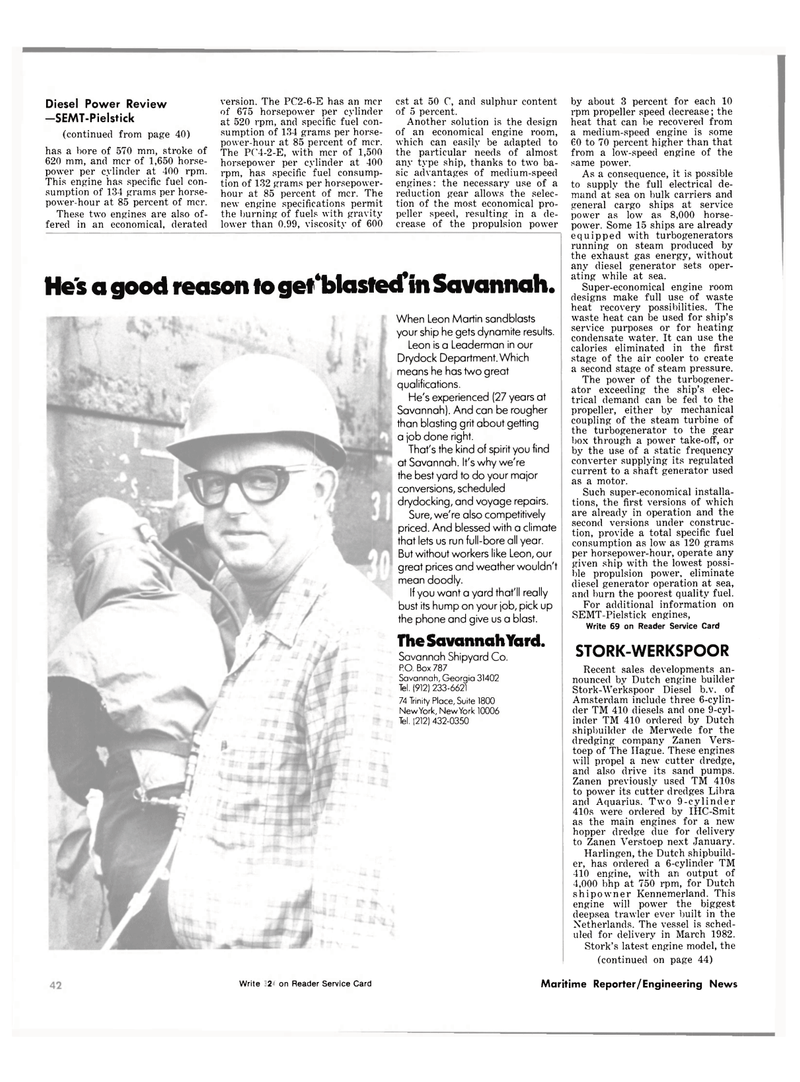
Page 38: of Maritime Reporter Magazine (October 15, 1981)
Read this page in Pdf, Flash or Html5 edition of October 15, 1981 Maritime Reporter Magazine
Diesel Power Review —SEMT-Pielstick (continued from page 40) has a bore of 570 mm, stroke of 620 mm, and mcr of 1,650 horse- power per cylinder at 400 rpm.
This engine has specific fuel con- sumption of 134 grams per horse- power-hour at 85 percent of mcr.
These two engines are also of- fered in an economical, derated version. The PC2-6-E has an mcr of 675 horsepower per cylinder at 520 rpm, and specific fuel con- sumption of 134 grams per horse- power-hour at 85 percent of mcr.
The PC4-2-E, with mcr of 1,500 horsepower per cylinder at 400 rpm, has specific fuel consump- tion of 132 grams per horsepower- hour at 85 percent of mcr. The new engine specifications permit the burning of fuels with gravity lower than 0.99, viscosity of 600 est at 50 C, and sulphur content of 5 percent.
Another solution is the design of an economical engine room, which can easily be adapted to the particular needs of almost any type ship, thanks to two ba- sic advantages of medium-speed engines: the necessary use of a reduction gear allows the selec- tion of the most economical pro- peller speed, resulting in a de- crease of the propulsion power by about 3 percent for each 10 rpm propeller speed decrease; the heat that can be recovered from a medium-speed engine is some 60 to 70 percent higher than that from a low-speed engine of the same power.
As a consequence, it is possible to supply the full electrical de- mand at sea on bulk carriers and general cargo ships at service power as low as 8,000 horse- power. Some 15 ships are already equipped with turbogenerators running on steam produced by the exhaust gas energy, without any diesel generator sets oper- ating while at sea.
Super-economical engine room designs make full use of waste heat recovery possibilities. The waste heat can be used for ship's service purposes or for heating condensate water. It can use the calories eliminated in the first stage of the air cooler to create a second stage of steam pressure.
The power of the turbogener- ator exceeding the ship's elec- trical demand can be fed to the propeller, either by mechanical coupling of the steam turbine of the turbogenerator to the gear box through a power take-off, or by the use of a static frequency converter supplying its regulated current to a shaft generator used as a motor.
Such super-economical installa- tions, the first versions of which are already in operation and the second versions under construc- tion, provide a total specific fuel consumption as low as 120 grams per horsepower-hour, operate any given ship with the lowest possi- ble propulsion power, eliminate diesel generator operation at sea, and burn the poorest quality fuel.
For additional information on
SEMT-Pielstick engines,
Write 69 on Reader Service Card
STORK-WERKSPOOR
Recent sales developments an- nounced by Dutch engine builder
Stork-Werkspoor Diesel b.v. of
Amsterdam include three 6-cylin- der TM 410 diesels and one 9-cyl- inder TM 410 ordered by Dutch shipbuilder de Merwede for the dredging company Zanen Vers- toep of The Hague. These engines will propel a new cutter dredge, and also drive its sand pumps.
Zanen previously used TM 410s to power its cutter dredges Libra and Aquarius. Two 9-cylinder 410s were ordered by IHC-Smit as the main engines for a new hopper dredge due for delivery to Zanen Verstoep next January.
Harlingen, the Dutch shipbuild- er, has ordered a 6-cylinder TM 410 engine, with an output of 4,000 bhp at 750 rpm, for Dutch shipowner Kennemerland. This engine will power the biggest deepsea trawler ever built in the
Netherlands. The vessel is sched- uled for delivery in March 1982.
Stork's latest engine model, the (continued on page 44)
He's a good reason to get'blastecf in Savannah.
When Leon Martin sandblasts your ship he gets dynamite results.
Leon is a Leaderman in our
Drydock Department. Which means he has two great qualifications.
He's experienced (27 years at
Savannah). And can be rougher than blasting grit about getting a job done right.
That's the kind of spirit you find at Savannah. It's why we're the best yard to do your major conversions, scheduled drydocking, and voyage repairs.
Sure, we're also competitively priced. And blessed with a climate that lets us run full-bore all year.
But without workers like Leon, our great prices and weather wouldn't mean doodly.
If you want a yard that'll really bust its hump on your job, pick up the phone and give us a blast.
The Savannah Yard.
Savannah Shipyard Co.
P.O. Box 787
Savannah, Georgia 31402
Tel. (912) 233-6621 74 Trinity Place, Suite 1800
New York, New York 10006
Tel. (212) 432-0350 14 Write 142 on Reader Service Card Maritime Reporter/Engineering News

 37
37

 39
39
